
Where to eat in the Dordogne
It's the heartland of confit duck, foie gras and 'black gold' truffles, but traditional Dordogne cuisine also embraces earthy, flavour-rich foods, most of which are preserved in no-nonsense cans and jars
At the edge of Issigeac's buzzing market, the pumpkin festival is in full swing. Fat, orange, bulbous pumpkins are piled high on the cobbled pavement. The scent of freshly baked pumpkin tarts wafts past on the breeze emanating from a striped marquee nearby. From behind a line of rickety trestle tables, cheery volunteers hand out paper plates by the dozen to a queue of eager customers.
This is autumn in the heart of the Dordogne, or Périgord, its old provincial name, and there's no better time to be here. While there might be a nip in the air, the sun is still shining, the leaves are turning a riot of colours and the tourists — well, most of them — have gone home, leaving a bounty of delicious food and wine for me to enjoy.
The village of Issigeac may be small, but its market is very impressive. Stalls line the narrow medieval streets, which are flanked with crooked, timber-framed buildings. The best of the region is here: bottles of shiny walnut oil, enticing jars of confit de canard, tins of smooth foie gras and vegetables so fresh they're still flecked with soil. I fill my basket with treats to cook later in my gîte, and get back into the car to drive north through the rolling fields and forests in search of more Dordogne delicacies.
Skinny silver birches tower high above the road, just holding onto the last of their yellow leaves, as I pootle down winding roads that follow the region's eponymous river in the beautiful village of Trémolat. The Michelin-starred restaurant Le Vieux Logis is set in an old priory; its creaking buildings are covered in vines and look out over exquisite gardens. It's a luxury hotel as well as a restaurant, but ebullient chef Vincent Arnould stays true to the region's cuisine and its traditions. While his fellow Michelin-starred chefs might turn their noses up at tinned ingredients, here in the Dordogne, preservation is king, he explains in his bright airy kitchen.
"The Périgord is a country of the duck, of foie gras and of conserving," he says. "It was one of the first places to conserve meat: once you've used the liver and the duck breast, they thought, what are we going to do with the rest?" Having worked in several other restaurants all over France, Vincent arrived as chef at Le Vieux Logis nearly 20 years ago and has always championed the local cuisine. "It's the tradition in this area to put everything in a tin, then you can keep it a long time and not waste anything. If you ask a Périgordian what they want to eat, they'll say 'duck, duck, duck' — it's incredible."
Over a sumptuous meal in the hotel's atmospheric dining room — set in the property's former tobacco-drying barn — I taste the tender duck legs and the heady walnut oil, as part of a surprisingly delicate and sophisticated tasting menu. The starter features a square of foie gras, which I've eaten so many times in France, turning a blind eye to its controversial provenance in the knowledge that the French are accepting of its production methods.
Force-feeding ducks and geese with grains to fatten up their liver is considered by many a cruel practice, but now that I'm here in foie gras' heartland, it's time to face up to reality and to see it for myself. Many of the foie gras farms in the Dordogne will happily welcome visitors to witness the 'gavage' (force-feeding process), so later that day I pay a visit to Domaine de la Barbe, a farm tucked away up in the hills south of the Dordogne river, not far from Trémolat.
In the early evening sun, the barns and sheds cast long shadows on the huge fields where young ducks and geese are grazing. Inside the barns, the more mature birds are kept in pens; it's here that I find Angelina, a cheery woman in her late 20s, dressed in overalls, complete with hairnet, plastic apron and gloves.
As we chat about the farm and the production of foie gras, I ask her what she likes about her job. "I've always liked animals, and I'm passionate about farming." This rather beauty pageant-esque answer seems strange to me, given foie gras' reputation, but she's happy in her work, explaining to me that, in the wild, the ducks would overeat naturally to prepare for their long migration.
She tells me she'll be feeding the ducks a mixture of ground corn and grain. She'll insert a soft, rubber tube into each animal's mouth and let in around 100g of feed. Then she'll feel each of their bellies to make sure they haven't been given too much. It takes her 40 minutes or so to feed around 200 ducks, and while it isn't exactly pleasant to watch, I come away questioning all methods of farming, from dairy to meat production, rather than condemning this one alone.

The Dordogne's other lauded product is produced more naturally: truffles. Although truffle-hunting season starts later in the year, I join Max, from local wine tour company Duck and Truffle, the next morning in a truffle grove to see how they're found. The mist is lingering on the fields as we drive through the countryside to a small farm in the hills above the Dordogne river.
Truffle hunter Sebastien Chinouilh greets us with an earnest smile and strong handshake then introduces us to Falco, his big black dog. Falco senses what's coming: from the moment his master picks up his small canvas shoulder bag and tools, Falco is in truffle-hunting mode. He leaps into the back of Sebastien's van and we all drive towards the truffière — the truffle grove — a grassy field dotted with small trees.
Sebastien's grandfather started the truffle plantation 28 years ago and experimented by injecting the truffle spores into the roots of oak and walnut trees. Although Sebastien has learned from his grandfather and father, there's no accounting for the unpredictable nature of growing this precious 'tuber melanosporum'. "It was a bad year, last year. We only found four or five kilos in the whole season," he says. "Two years ago, we'd find that much each week."
Although Falco is trained to locate truffles, Sebastien knows how to read nature's signs too. "Where you see little red flies hovering over the ground, chances are there's a truffle there. The flies lay their eggs near a truffle, so when the maggots hatch they can feed on them. As we follow Falco and Sebastien between the small trees, Falco sniffing as he goes, Sebastien explains that when truffle is sold by the kilo, there's little wonder it's called 'black gold'. "But you only need one truffle to really enhance a meal for two, and 10g costs €6 or €7 (£5 or £6)."
Sebastien spots some flies hovering over the ground and calls Falco over for a sniff. "This is one of the smaller trees," he says, crouching below the shrub that's little more than six feet in height, "but there's always a truffle here. The spores can actually hamper the growth of a tree."
He digs into the ground with a small metal tool and pulls out a brown lump covered in earth. As Sebastien brushes off the soil, I can't help wondering how anyone first thought to eat something that so closely resembles animal droppings. Sebastien sniffs it and squeezes it, declaring it a bit too spongey for consumption.
When we return to the farm, Sebastien's wife has prepared me and Max a light meal of scrambled eggs with truffle shavings, accompanied by the local white wine. "Truffles freeze well," she says. "So we always have a supply." It's hard to believe something as simple as scrambled eggs could be quite so delicious with the addition of one ingredient, but this is the Dordogne, where even the simplest meal is a gourmet treat.
A taste of Dordogne
One of the Dordogne's few Michelin-starred restaurants, Le Vieux Logis is set in an ancient priory and has been welcoming guests for decades. Its more casual restaurant, Bistrot de la Place, is also excellent.
The Sunday morning market offers everything from local delicacies such as walnut oil and confit de canard to British favourites such as Bakewell tarts, for the local expat community.
As well as having one of the best markets in the area, the streets of Sarlat are lined with numerous boutiques offering tins of foie gras, local aperitifs and liqueurs, biscuits and cakes.
Published in the September 2018 issue of National Geographic Traveller (UK)







